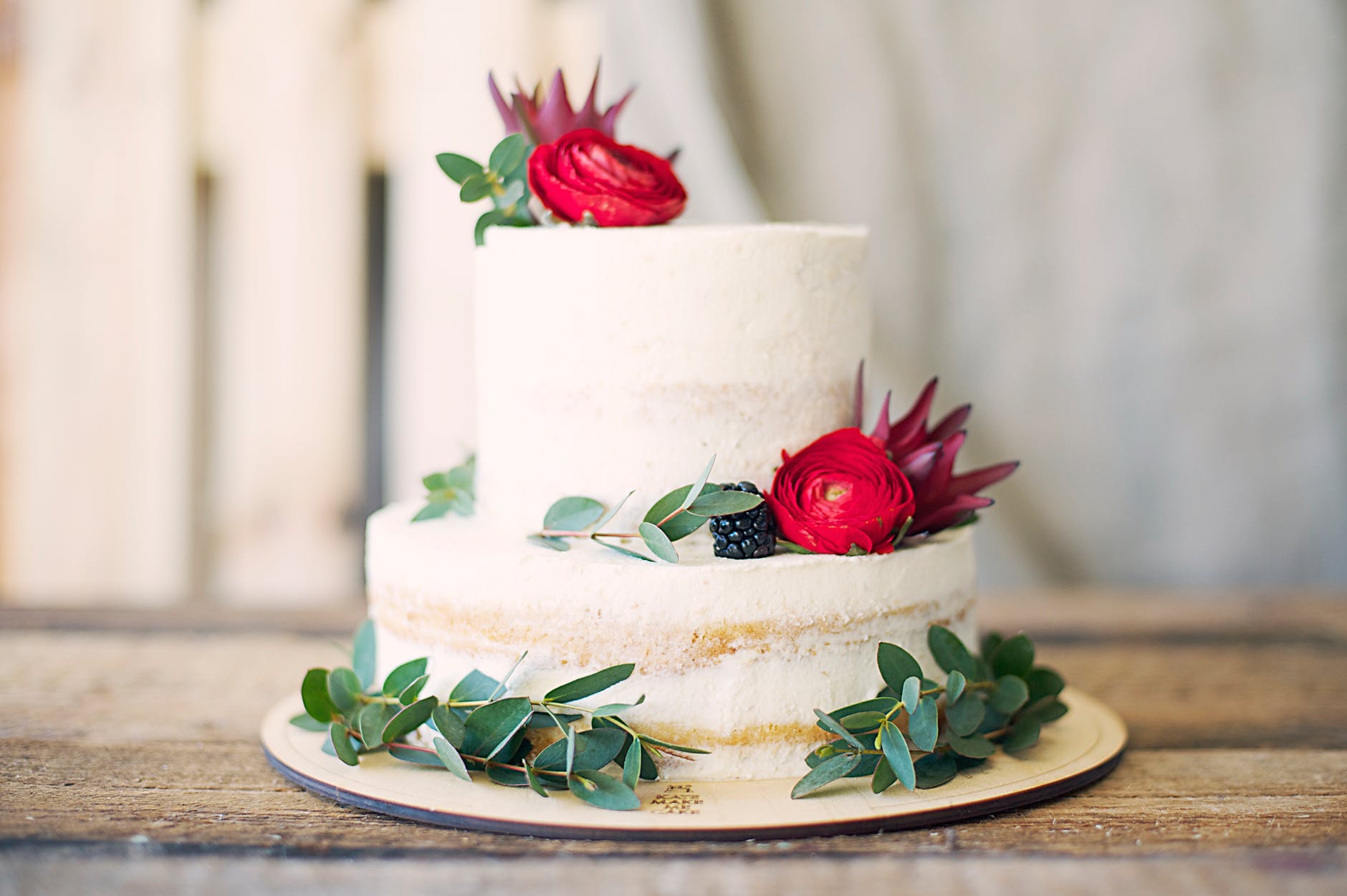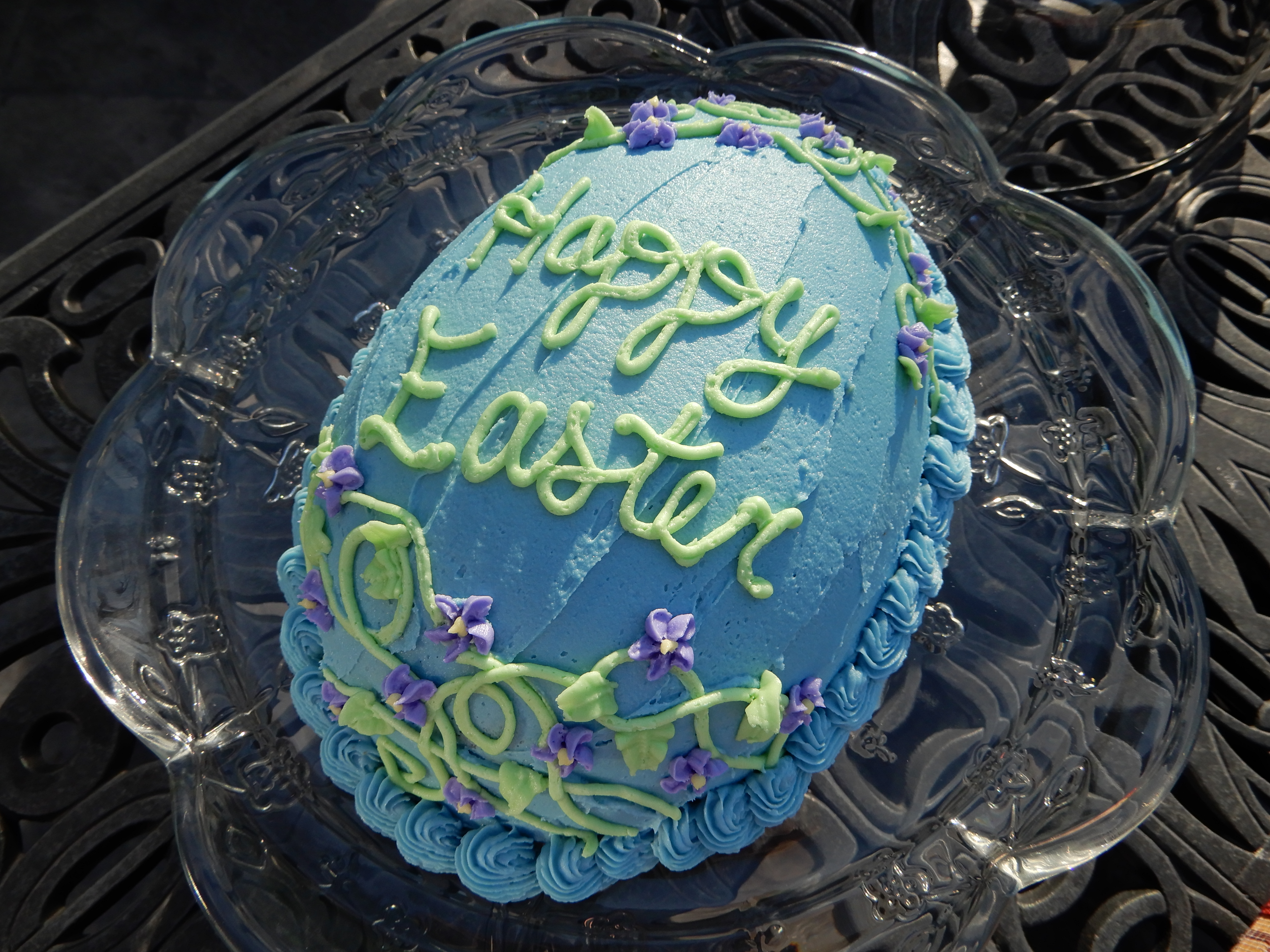I will always remember any holiday or family celebrations as happy times and SWEET times. Tables overflowed with mouthwatering desserts: sweet yet savory chocolate chip cookies, tangy zuccherinis, simple pizzelles, Grace’s (aka Mom-Mom) filled cookies, rich chocolate crinkles, cream puffs you drool over, cannolis bursting with sweet ricotta, gorgeous Easter egg cakes, and at least three different pies.
My Mom-Mom would pipe gorgeous flower designs on the cakes; there was always one vanilla with vanilla icing and one marbled with chocolate icing. For a long time, it wasn’t Easter unless we ate Easter egg cake.
This year, I decided to give them a try for Easter since we weren’t hosting anyone, so if I messed up it wasn’t going to be a big deal :).
I was excited to work on cakes because recently I’d only been making cupcakes.
My buttercream recipe requires one stick of butter per batch. After baking two cakes, I didn’t have enough butter for the icing. Thankfully, my neighbor lent me some; however, I didn’t realize it was different from what I normally use until I mixed it all up.
The buttercream still came out well and possibly better than ever but I didn’t know why. I decided to do research on the history of buttercream and I ended up falling down into a big hole of baking facts!
Keep reading to learn about buttercream, what the surprise was inside the butter, and how my egg cakes turned out!
Enjoy
The History of Buttercream:
The 17th century was filled with creative innovation, including documentation of the first frosted cake! In 1655, a French chef introduced the first multi-layered cake; each layer of cake was followed by a layer of icing. The frosting included eggs, sugar, and rosewater.
Shortly after, the traditional wedding cake became popular in the late 1700s from aristocrats’ weddings. It was Queen Victoria of England who, in 1840, began the multi-layered white iced wedding cake trend that we still see today, over 180 years later.

Traditional White Cake
From buttercreams and sweet frostings to fluffy meringues, today, there is a wide variety of icings to choose from.
There are four popular types of buttercream: American buttercream, Swiss buttercream, Italian buttercream, and French buttercream. All of these types are similar to one another, the biggest difference between each is the order of directions and how the ingredients are used.
Today, buttercream dominates the cake industry. Bakers use it to coat cakes, create stunning flower arrangements, and more. For a few years, during most of the 2010s, fondant, a type of marshmellowy cake covering became quite prominent. Top bakeries like the once very popular Carlos’ Bakery from Cake Boss, only used buttercream for “old school” piping; fondant was the main medium for decorating.

Fondant Cake
Flash forward to today and buttercream is back in style and stronger than ever! Cupcakes have become extremely popular again because they are COVID regulation friendly (ie. single serving). Moreover, a new decoration technique called buttercream painting, with a palette knife, has come to the forefront of cake decorating. I think this will be my next adventure.

Buttercream Painting
Another popular style is bare buttercream cakes (I definitely just made that name up because I don’t know the actual name). These cakes tend to look more rustic and boast thin layers of buttercream where the cake can shine through. They are typically decorated with a white buttercream and then adorned with fresh fruit or flowers. These are popular with rustic themed weddings.

Bare Buttercream Cake
Most of the cakes I make tend to be a mixture between traditional and modern techniques. I want to branch out in the next few months and make cakes that are strictly within each of these categories.
My Buttercream Recipe:
Ingredients:
- 1/2 cup butter
- 1 TBSP milk
- 1 tsp vanilla extract
- 3-5 cups powdered sugar (this depends on the consistency you want)
First, make sure your butter is room temperature (do not melt it). Beat the butter to a smooth consistency in your mixer. Beat in the vanilla and some or all of the milk (depends on the size of your bowl because it may splash). Gradually add scoops of powdered sugar until frosting reaches desired thickness. Be mindful to stop whipping occasionally to scrape the bottom and sides of the bowl and break up air bubbles.
This recipe should make enough to ice about 6 cupcakes (with a big swirl, about the size pictured below)

What was the surprise?
For Easter 2021, it was only my immediate family because we were trying to stay safe from the COVID-19 virus. Because it was such a small gathering, I only made two cakes rather than our usual spread of desserts.
I made a simple vanilla cake and my grandma’s special chocolate cake recipe. Both were made into the shape of an egg. When I went to make my buttercream, I realized I did not have enough butter to make the right amount of frosting. Thankfully, my neighbor was kind enough to give me a few sticks.
Normally, I make my buttercream with unsalted butter. I didn’t realize until after I beat in everything but the powdered sugar that the butter was salted!
To my surprise, three things happened:
- I didn’t have to use as much powdered sugar as I normally do to get the right consistency
- The icing was stiffer and set quicker
- It tasted better (it was more buttery)
I am super picky about the consistency of my buttercream when I am using it for piping. I don’t know if maybe it was all in my head, but there was something special about using the salted butter rather than unsalted. Also, the salt cut the sweetness of the powdered sugar, I didn’t feel like I was going to get a tooth ache while eating a cupcake.
My egg cakes:


Honestly, I was pretty happy with how they turned out. I think this batch of buttercream hardened beautifully which made my rose application process much easier. Nevertheless, I still have a lot to improve:
- My rose petals can be crisper
- The colors could be deeper and more realistic
- I waited too long to pipe the border of the bouquet cake, so the icing was hard making the border shaky looking
- My violets and the leaves could be much cleaner
- The border on the blue cake is wobbly from uneven pressure when piping


Clearly, I have a lot to improve!
Drop in the comments and let me know what kind of butter you use in your buttercream and if you know why salted butter may be better than unsalted.
I hope everyone is having a lovely spring week!


I think they are ‘marvelous’…Mom Mom would be proud!👏👏. You need to share this with her!
LikeLiked by 1 person
Thank you Grammy! I definitely will!
LikeLike
I would say they are lovely. You inspire me to try.
LikeLiked by 1 person
Thank you so much and that’s great, I’d love to see the final products!
LikeLiked by 1 person
When I get up the nerve to make some, I will post the pictures.
LikeLike
Stunning cakes.
Gwen.
LikeLike
this was very informative reading. I never knew that the multilayer wedding cake was from Queen Victoria’s time!
You did a great job making the cake and buttercream. Looks pretty & delicious
LikeLiked by 1 person
Thank you very much! I also thought it was super interesting that the wedding cake originated from Queen Victoria. That’s why I love writing these articles, I learn a lot of new fun facts 🙂
LikeLike
Pretty! This has been an incredibly wonderful post. Thanks for providing this information.
LikeLike